Tuesday, January 31, 2006
Chesapeake Bay Maritime Museum Internships
"The Museum's internship program is an integral part of its educational activities. Internships provide students with the opportunity to gain training in their specific area of expertise as well as an overview of Museum practices and policies. Individuals working towards undergraduate or graduate degrees in Museum studies, history or related fields and individuals with formal boat building training are invited to apply."
For more information and an application form please take a look at their website.
Fisher Poets Gathering
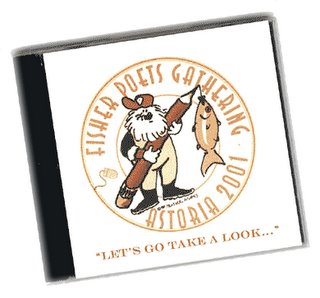
More than 50 writers and musicians who work in the commercial fishing industry are set to gather in Astoria Feb.24 to 26, 2006 for the ninth annual Fisher Poets Gathering.
The Gathering is an event that brings together fishing industry-related men and women from several states to read their poems and stories, sing their songs, and socialize in a pub atmosphere. The audience comes from local towns and all over the country.
The following workshop schedule is planned.
Leading off the topical workshops is Trevor Corson from Washington DC, author of the novel Secret Life of the Lobster, on writing fiction and the Maine lobster fishing industry. Corson’s book first appeared as an Atlantic Monthly article. Twenty Years of Alaska Fisherman’s Journal follows, a talk by retiring editor-in-chief John Van Amerongen of Vachon WA, on the life of this influential industry journal that ceased publication in January 2006. Irene Martin of Skamokawa WA reports on her study of the socio-economic impact of the Columbia River gillnet fishing industry, and leads discussion on the issues involved.
This would be the perfect opportunity to check out the Cannery Hotel mentioned in a previous post.
Monday, January 30, 2006
Life at sea
ETA: See also the Oct. 6, 2008 update.
As historians of the future research to discover the nature of life at sea for today's sailor, merchant and naval, alike I hope that they are able to view (and analysize) this very informative video:
All 5 minutes and 36 seconds were produced by the CS6 (can anyone tell me what that means?) crew of the USS Enterprise. The video is a spoof of the Numa Numa video (which I confess I've never seen). According to Wikipedia the Numa Numa spoofs are based upon the Moldovan Romanian pop song "Dragostea Din Tei" by O-Zone.
It's an impressive piece of work!
This is the USS Enterprise - also known as the production studio:
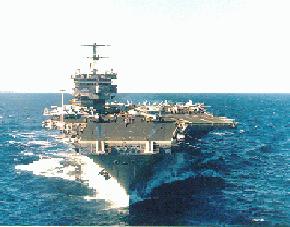
Harassment of harassers
Watson contends that the South Africans were acting under pressure from the Japanese, who feared that the Farley Mowat had docked to refuel and then resume its harassment of the whaling boats. The boat had recently spent 50 days in the Antarctic with vessels from Greenpeace on a mission to prevent Japan's whaling fleet from killing 850 minke whales and 10 fin whales.
Canadian Anti-whaling Ship Detained
Dwayne Clark's Boating Safety Law and News Blog hosts an excellent video on a dangerous Greenpeace/whaler encounter.
Final Resting Place

The Canadace, an 1818 Boston-built ship, whose life includes trading in the Pacific, arctic whaling, and a quiet stint in the mud under San Fransciso, will soon become the centerpiece of the San Francisco History Museum when it opens in 2008 at the Old Mint in downtown San Francisco.
The full, and interesting story can be found in the San Francisco Chronicle.
Friday, January 27, 2006
Job posting: Development Coordinator / Curator for the USS Constellation Museum
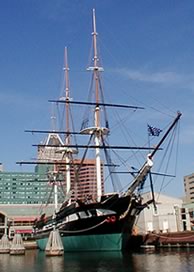 The USS Constellation Museum, located in Baltimore, Maryland, is pleased to offer, to qualified candidates, the opportunity to apply for the position of Development Coordinator / Curator. The Development Coordinator / Curator for the USS Constellation Museum is a challenging position combining duties usually performed by several individuals in a larger institution. These include, but are not limited to, the responsibilities of a Curator, Registrar, and Museum Historian, as well as exhibit planning and design, exhibit maintenance, grant research, grant writing, general fundraising, and project management,. Creativity and artistic aptitude for exhibit development and interpretation are very important to this position, as is the ability to research and relate to potential donors. The Development Coordinator / Curator must make a strong commitment to preserving the artifacts in our care, enriching the public experience of the Museum, as well as assisting the Museum's Executive Director with the planning and implementation of the institution's fundraising strategy. The ability to speak publicly on the history of the ship, the Museum's restoration efforts, and the need for support is also important. Applicants must have an Masters in Museum Studies or related discipline, and at least 5 years experience in museum operations or related field. Please send resume' and cover letter along with an example of your writing to:
The USS Constellation Museum, located in Baltimore, Maryland, is pleased to offer, to qualified candidates, the opportunity to apply for the position of Development Coordinator / Curator. The Development Coordinator / Curator for the USS Constellation Museum is a challenging position combining duties usually performed by several individuals in a larger institution. These include, but are not limited to, the responsibilities of a Curator, Registrar, and Museum Historian, as well as exhibit planning and design, exhibit maintenance, grant research, grant writing, general fundraising, and project management,. Creativity and artistic aptitude for exhibit development and interpretation are very important to this position, as is the ability to research and relate to potential donors. The Development Coordinator / Curator must make a strong commitment to preserving the artifacts in our care, enriching the public experience of the Museum, as well as assisting the Museum's Executive Director with the planning and implementation of the institution's fundraising strategy. The ability to speak publicly on the history of the ship, the Museum's restoration efforts, and the need for support is also important. Applicants must have an Masters in Museum Studies or related discipline, and at least 5 years experience in museum operations or related field. Please send resume' and cover letter along with an example of your writing to:Development Coordinator / Curator Search
USS Constellation Museum
Pier 1, 301 East Pratt Street
Baltimore, MD 21202
Alternately, you may e-mail your information to: admin@constellation.org and put Development Coordinator / Curator Search in the subject line. Complete job description and salary / benefit information available upon request. The USS Constellation Museum is an equal opportunity employer.
Thursday, January 26, 2006
Own a plank: USS/CSS Waterwitch
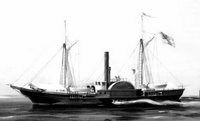 For the first time in 140 years, Columbus, Georgia is about to build a Civil War era combat ship. Then, it was the ironclad ram CSS Jackson, today, it’s the USS Waterwitch, a classic side wheel steamer of more than 160 feet.
For the first time in 140 years, Columbus, Georgia is about to build a Civil War era combat ship. Then, it was the ironclad ram CSS Jackson, today, it’s the USS Waterwitch, a classic side wheel steamer of more than 160 feet.A blockader built in 1852, the Waterwitch was made famous by a daring Confederate Navy commando raid to capture the ship near Savannah in 1864. Thus, this ship has the unique history of being both the USS AND the CSS, Waterwitch.
The National Civil War Naval Museum at Port Columbus is raising fund to rebuild this ship. Fund raising includes an own a plank promotion.
Wednesday, January 25, 2006
Title Not-Withstanding
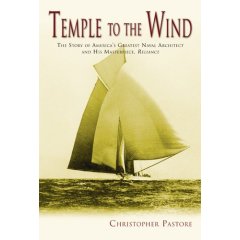 Christopher Pastore's Temple to the Wind : The Story of America's Greatest Naval Architect and His Masterpiece, Reliance
Christopher Pastore's Temple to the Wind : The Story of America's Greatest Naval Architect and His Masterpiece, Reliance"Temple to the Wind is an intriguing study of the legendary Captain Nat, his colleagues, his competitors and the designs he crafted leading up to the largest of them all, Reliance. In the process, author Chris Pastore has compiled a revealing image of yacht racing for the America's Cup as it existed a century and more ago." --John Burnham, editor, Sailing World
Sunday, January 22, 2006
Sloop Clearwater undergoing $200 million renovation
 Keith Eddings of The Journal News reports that "thirty-seven years after it first sailed up the Hudson and helped launch the campaign to restore the river, the sloop Clearwater has been lashed to a dock in this upstate village and stripped of its mast, rigging, bowsprit and half its deck for a major restoration of its own."
Keith Eddings of The Journal News reports that "thirty-seven years after it first sailed up the Hudson and helped launch the campaign to restore the river, the sloop Clearwater has been lashed to a dock in this upstate village and stripped of its mast, rigging, bowsprit and half its deck for a major restoration of its own."The article includes a well done slide show on the Clearwater's history and restoration.
For an update on other aspects of the Clearwater - it's future plans, past crew and exploits visit http://www.clearwater.org/index.html
Friday, January 20, 2006
Another first in maritime travel
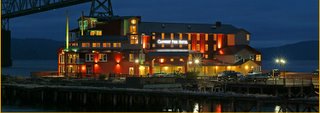 A few months ago I wrote about the Ocean liner-style hotel in NYC. Looks like a new hotel in Astoria is more my speed. The Cannery Pier Hotel is Astoria’s newest luxury boutique hotel, built on the site of the former Union Fish Cannery 600 feet into the River. The Hotel offers guests unparalleled views of a real working river, as well as views out to Cape Disappointment Lighthouse and nearby Washington.
A few months ago I wrote about the Ocean liner-style hotel in NYC. Looks like a new hotel in Astoria is more my speed. The Cannery Pier Hotel is Astoria’s newest luxury boutique hotel, built on the site of the former Union Fish Cannery 600 feet into the River. The Hotel offers guests unparalleled views of a real working river, as well as views out to Cape Disappointment Lighthouse and nearby Washington.The Hotel's impressive website includes (and this is why its impressive) a page with slide shows of freighters passing the hotel and a history of the Cannery:
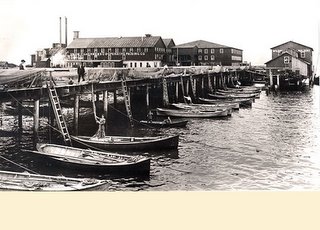
The Cannery Pier Hotel rests on the 100 year-old pilings that formerly supported the Union Fisherman's Cooperative Packing Company. Formed in 1897, it was the result of a turbulent time that favored big business cannery owners instead of the fishermen. Disputes with cannery owners about prices per fish started in 1876, with fishermen going on strike, and in 1880 they formed the Columbia River Fishermen's Protective Union. Tensions came to a head in 1896 when the fishermen went on strike again. Two strike-breakers were shot and more violence threatened, and the Oregon National Guard was called in to break the strike. After this, about 200 fishermen (mostly Finnish) came together, pooled their resources, and formed the Union Fisherman's Cooperative Packing Company. By 1904, it had become the largest cannery in Astoria. It remained a fishermen-owned business until the late 1940's.
Thursday, January 19, 2006
Job Posting: Curator Wisconsin Maritime Museum
Application due date: 2006/02/06
Salary range: salary commensurate with experience
Web Address: www.wisconsinmaritime.org
The Wisconsin Maritime Museum, an AAM accredited institution and Smithsonian Affiliate, is seeking an experienced curator with expertise in maritime history. Knowledge of American naval history and Great Lakes maritime history and culture is a plus.
With 60,000 sq. ft. (30,000 sq. ft. added in 2003) of modern facilities and the nation's most completely restored WWII submarine, the Museum offers an exciting opportunity for a highly qualified individual to guide the Great Lakes' premier maritime museum. The curator will be responsible for the care and management of the Museum's substantial collections and archives; development of exciting new exhibits planned for 2007; maintenance and enhancement of existing exhibits; and will supervise the Museum Educator in development of innovative, academically grounded educational programming for the public and a formal, comprehensive training program for docents and volunteers.
Responsibilities / Exhibits:
Develops annual exhibit calendars and exhibit development schedules;
Forms and works closely with exhibit development committees to develop new exhibits and enhance existing exhibits;
Researches, develops, supervises, and manages exhibitions and their installation;
Supervises temporary assistants, volunteers, and interns;
Proposes and manages curatorial/exhibition budgets, with approval of Executive Director;
Collaborates with other institutions, including the Smithsonian Institution, and collectors to secure the loan of items for exhibitions; provides Standard Facility Report as needed;
Supervises the preparation of loan agreements, insurance coverage, and condition reports;
Designs exhibition installations; works with part-time assistants to install exhibits;
Assists Executive Director with presenting proposals to potential exhibit sponsors;
Collaborates with Museum Educator to formulate exhibit-related programming and docent training;
Conducts lectures, gallery walks/tours as needed;
Works closely with Marketing and Media Relations Coordinator to design exhibit-related material, including didactics, invitations, brochures, and other materials;
Assists Media Relations/Events Coordinator and other staff with generating written material for exhibits and grant proposals;
Represents museum as spokesperson during exhibit-related interviews with media;
Attends exhibit sponsors private-event nights and Museum fund-raising events;
Builds strong rapport with local community, educators, and collectors.
Responsibilities / Collections:
Oversees the management, care and maintenance of the Wisconsin Maritime Museum facilities (including galleries and on-site and off-site storage), including security and environmental conditions;
Oversees care and preservation of WWII submarine; schedules and coordinates submarine advisory committee meetings;
Collaborates with Executive Director and Collection Committee to develop a collections acquisition plan, implement systems, policies and procedures of collection;
Works closely with the Collections Manager/Registrar who monitors condition and placement of all works within galleries, archives, and storage;
Selects items for, installs and manages rotating exhibits of collection;
Supervises the Collections Manager/Registrar who researches, documents, and maintains collection files on computer, off-site backup and hard copy;
Recommends works for acquisition/de-accession and preservation/conservation to Collection Committee; schedules committee meetings.
Qualifications:
Minimum, M.A. with 5-7 years of museum experience in museum studies. Ph.D. in field of interest is highly desirable;
Curatorial experience, including experience managing major traveling exhibitions;
Exhibit design/development experience required;
Meticulous research and writing skills, excellent verbal communication skills;
Excellent organizational/supervisory skills, including ability to multitask while paying careful attention to detail;
Strong interpersonal skills; must work effectively in collaborative team environment;
Proficiency in electronic records management, digital technologies and programs including Microsoft Word, PowerPoint, and PastPerfect;
Self-motivated, energetic leader with ability to visualize the future.
Equal Opportunity Employer; salary commensurate with experience.
Send cover letter with résumé, writing sample, and three references to Executive Director Norma Bishop, nbishop@wisconsinmaritime.org or FAX to 920-684-0219 no later than February 6, 2006. Posted January 14th
Internship Opportunities
For more information about the internships contact:
Cristin Waterbury, Wisconsin Maritime Museum, 75 Maritime Drive, Manitowoc, WI 54220; or via email to cwaterbury@wisconsinmaritime.org.
Answer: 39 days, 3 hours, 35 minutes and 47 seconds.
Wednesday, January 18, 2006
Congratulations
According to an article in the Manitowoc Herald Times Bill Thiesen will be leaving Manitowoc for his new position as the Coast Guard's Atlantic area historian, responsible for a territory covering the eastern U.S., including the Caribbean and overseas stations, and operating out of the Coast Guard's Atlantic Area Command Center in Portsmouth, Va. His duties will include public outreach, researching historical questions for the public and the Coast Guard's Public Affairs Office, overseeing the collection of historically significant artifacts and documents at Coast Guard installations throughout the region, conducting oral interviews of veterans and active Coast Guard personnel and preserving the history of the Coast Guard.
Thiesen's new book Industrializing American Shipbuilding: The Transformation of Ship Design And Construction, 1820-1920 (New Perspectives on Maritime History and Nautical Archaeology)
New Book: Sailor-Painter
 Sailor-Painter: The Uncommon Life of Charles Robert Patterson
Sailor-Painter: The Uncommon Life of Charles Robert PattersonThis book wonderfully explores the full extent of Patterson's career. But it is more. It's a book about the 'last days of sail', the ships and the people who wanted to memorilize those days.
As the title suggests, Charles Robert Patterson was both a sailor and a painter. Born in 1880, Patterson soon was sailing across oceans and around Capes. Retiring from sea in 1899 he first worked as a newspaper illustrator, but moved on to ship paintings by the 1920s. Painted for important American institutions, businesses, and individuals; among them the U.S. Naval Academy, W.R. Grace & Company, J. P. Morgan, Jr., and Vincent Astor, Patterson produced over 400 works.
Tuesday, January 10, 2006
Influenza of 1918 and the US Navy
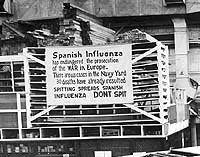 The Navy Department Library has posted some very interesting documents and photographs on the US Navy's handling of the 1918 Influenza outbreak.
The Navy Department Library has posted some very interesting documents and photographs on the US Navy's handling of the 1918 Influenza outbreak.In 1918, Navy and Marine patients totaling 121,225 were admitted at Navy medical facilities with influenza. Of these patients, 4,158 died of the virus, and sick patients spent over one million sick days in these facilities worldwide.
Influenza of 1918 (Spanish Flu) and the US Navy
Shipbreaking
The "Ghost Fleet" contains 129 old naval ships that sit idle in a half-dozen ports around the U.S. These ships, maintained by the U.S. Navy and the U.S. Maritime Administration have become the target for the industry known as shipbreaking. All but shut down for a few years in the late 1990s amid environmental concerns, the shipbreaking business in the U.S. is now making a comeback. It is being fueled by a convergence of government action with developments in the global steel, energy and freight industries.
The driving force is the steel business, which is booming amid demand from China and other fast-growing economies. Just under two-thirds of the one billion tons, or $400 billion, in new steel produced each year comes from iron ore; the rest is recycled from torn-up cars, washing machines, ships and other forms of scrap metal.
But there's a shortage of old ships available to feed the steel industry's voracious appetite. With a global commodity boom under way, older ships are being kept in operation longer than normal to carry freight, oil, coal and other raw materials, not to mention huge amounts of scrap steel. Shipbuilders are expanding production, but it typically takes three years to build and launch a new freighter. Despite the huge demand for steel, Lloyd's List, a London-based maritime-industry trade publication, reports that about 232 vessels were scrapped in the first 10 months of 2005, down from 422 ships scrapped during the same period last year.
The U.S. has one of the largest government-owned stockpiles and an active program to get rid of the ships for scrap or other uses. Marad maintains three fleets in Virginia, Texas and California, spending thousands a year per ship trying to prevent corrosion, mold and mildew growth. As ship custodians for the federal government, the agency decides when to get rid of ships by paying a company to scrap them. Otherwise, the agency can sink ships in the ocean, either as part of military testing or to create artificial reefs for fish and scuba divers.
Sunday, January 08, 2006
Sunken Treasure Exhibit
The highlight of the newly renovated museum is the Sunken Treasure Gallery, which has hundreds of artifacts from a sunken ship. The gallery also has a state-of-the art interactive exhibition, where visitors can take a closer look at a diver's helmet and watch video clips of the excavation of the sunken treasures.
The sunken treasures were discovered by a French oil company when the remains of an unidentified shipwreck loaded with valuable stoneware and porcelains were found under 63 meters of waters.
Approximately 15,000 artifacts from late 15" and early 16"' century porcelains, earthenware, gongs, cannons and ivory were among those recovered from the wreck.
The first exhibition of the sunken ship was held at the lobby of the Brunei Museums. It was officially launched by the former Minister of Culture, Youth and Sports and sponsored by TOTAL in 1999.
This was followed by an international exhibition from September 2001 to March 2002, on the banks of River Seine. Coinciding with the 20th anniversary of diplomatic relations between Brunei and Australia in 2003, an exhibition on the "Sunken Treasures of Brunei Darussalam" was held in Australia from December 16, 2003 until the end of 2004. During this period, the exhibition was held at the National Maritime Museum, Sydney, the National Museum Canberra and New Maritime Museum in Fremantle, Western Australia.
Saturday, January 07, 2006
Maritime Quote of the Day
So we beat on, boats against the current, borne back ceaselessly into the past.
-The Great Gatsby
(And that's all I have to say about that)
Friday, January 06, 2006
Job Posting: Curator of Education
 The Minnesota Marine Art Museum in Winona, MN is seeking an energetic, highly organized, and creative museum professional to serve as its Curator of Education. The successful applicant will plan, develop, implement and oversee all aspects of museum educational programs.
The Minnesota Marine Art Museum in Winona, MN is seeking an energetic, highly organized, and creative museum professional to serve as its Curator of Education. The successful applicant will plan, develop, implement and oversee all aspects of museum educational programs.Museum education experience required, and an M.A. in museum studies, education, or art history preferred.
To Apply: Please send resume/curriculum vitae, cover letter, and supporting materials (including names, numbers, and addresses of three references) via email to dbenden@minnesotamarineartmuseum.org or fax to (507) 474.6625.
Deadline: Applications received by January 20th, 2006 will receive first consideration.
The Minnesota Marine Art Museum is presently under construction on Riverview Drive, near the Winona Commercial Harbor. The Museum is a project of Winona's Maritime Heritage Society and will feature the Burrichter-Kierlin Maritime Art Collection, the Henry Bosse Photography and Map Collection, the Leo Smith Folk Art Collection and the U.S. Army Corps of Engineers Mississippi River dredge, William A. Thompson, as an exhibit adjacent to the museum building. The museum is scheduled to open in 2006.
Thursday, January 05, 2006
AHA
The session on The Transatlantic and Intra-American Slave Trades and Black Population Trends in the Americas before 1820: An Attempt to Assemble the Big Picture includes a paper by David Eltis, Emory University entitled The Transatlantic Slave Trade: Revised Estimates of the Volume and Direction Derived from The Second Edition of the Cambridge Database of Voyages.
The session entitled on "Social Shaping of Weaponry: The History of American Military Technology in Context: Part 1—The Formative Years" includes two maritime papers; America’s Love of Technology: The Dahlgren Gun and John Dahlgren by Thomas Legg, West Chester University; and The Coast Survey and Military Cartography Albert E. Theberge Jr., National Oceanic and Atmospheric Administration.
In addition the conference features a roundtable on "Riverscapes and the Formation of National Identity".
Tuesday, January 03, 2006
Entires are now being taken for 2007!
Twenty Six team entries from around the world are competing against each other on equal terms across three different classes: solo, pairs, and fours.
This is the 4th Atlantic Rowing Race, the first being held in 1995.
The website(s) for this race http://www.atlanticrowingrace.co.uk/ are fantastic and some library somewhere should be archiving this (Anyone interested?). Not only does the Race have a terrific site featuring a position map, daily updates, and history, it also has links to the urls of all the teams. Many of the competitors are keeping daily blogs that are really amazing. Take today's entry from solo rower Chris Martin (now keep in mind he is rowing in the middle of the Atlantic):
The Atlantic is big. It’s really big. Unfortunatly for me I’ve only just realised how hugely large and vast it actually is.
The waves over the past few days have been really strange. Not very big. (There isn’t much wind to make them large either) and they seem to be moving a lot slower than they have been in the past. Either that or my brain is slowing down…
This is the most bizarre race. If you want to catch the crew in front a push must last days or weeks not just strokes. 40 miles from the next boat doesn’t sound like much but it could take a week or so to catch that crew depending on how fast they are going. It’s crazy I tell you. Maybe I should have been paying more attention at the start but the problem for solos is that we have to sleep sometime, and then the boat goes anywhere it wants to. It’s strange to look back on the start of the race. It seems such a long time ago.
Chris Martin's Blog
Monday, January 02, 2006
Museum on the move

The Great Lakes Historical Society will be moving their Inland Seas Maritime Museum from Vermilion, Ohio to a new maritime museum to be located on the Black River in the Port of Lorain Resort. Current plans for for the new 40,000+ square foot facility to feature an exciting mix of cutting edge technology and world-class artifacts . The facility will also have docking space for tall ships and other touring maritime attractions. The Society hopes to raise the needed revenue over the next five years.
The new museum would be part of a Las Vegas-style gambling casino to be built on the site of the former Lorain Pellet Terminal. The casino plans would be to build on 5.6 acres that the city will sell to the Eastern Shawnee for $6 million. The tribe-owned-and-operated facility would anchor a major hotel-retail-museum development on the city's prime lakefront property, which will be leased to the Eastern Shawnee, according to a ''Lorain Harbor Resort'' plan announced by Mayor Craig Foltin and Chief Charles Enyart.
